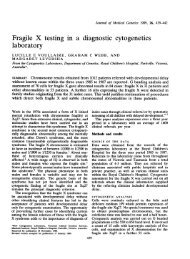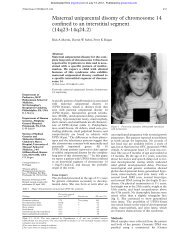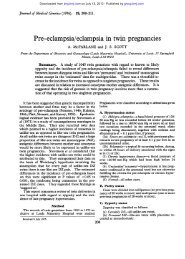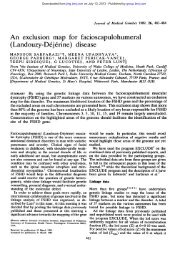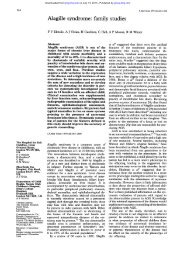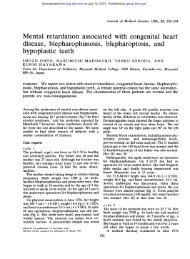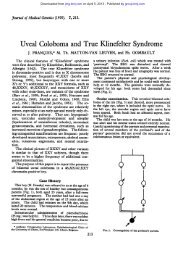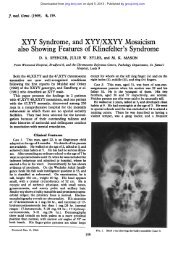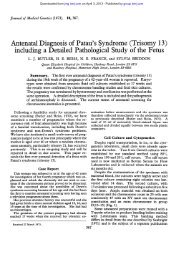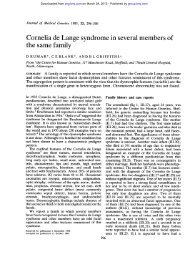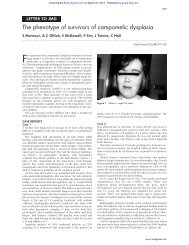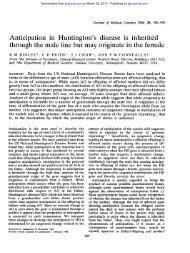Rett syndrome: clinical review and genetic update - Journal of ...
Rett syndrome: clinical review and genetic update - Journal of ...
Rett syndrome: clinical review and genetic update - Journal of ...
Create successful ePaper yourself
Turn your PDF publications into a flip-book with our unique Google optimized e-Paper software.
Downloaded from jmg.bmj.com on August 25, 2013 - Published by group.bmj.com<br />
1<br />
REVIEW<br />
<strong>Rett</strong> <strong>syndrome</strong>: <strong>clinical</strong> <strong>review</strong> <strong>and</strong> <strong>genetic</strong> <strong>update</strong><br />
L S Weaving, C J Ellaway, J Gécz, J Christodoulou<br />
...............................................................................................................................<br />
<strong>Rett</strong> <strong>syndrome</strong> (RS) is a severe neurodevelopmental<br />
disorder that contributes significantly to severe intellectual<br />
disability in females worldwide. It is caused by mutations in<br />
MECP2 in the majority <strong>of</strong> cases, but a proportion <strong>of</strong><br />
atypical cases may result from mutations in CDKL5,<br />
particularly the early onset seizure variant. The relationship<br />
between MECP2 <strong>and</strong> CDKL5, <strong>and</strong> whether they cause RS<br />
through the same or different mechanisms is unknown, but<br />
is worthy <strong>of</strong> investigation. Mutations in MECP2 appear to<br />
give a growth disadvantage to both neuronal <strong>and</strong><br />
lymphoblast cells, <strong>of</strong>ten resulting in skewing <strong>of</strong> X<br />
inactivation that may contribute to the large degree <strong>of</strong><br />
phenotypic variation. MeCP2 was originally thought to be<br />
a global transcriptional repressor, but recent evidence<br />
suggests that it may have a role in regulating neuronal<br />
activity dependent expression <strong>of</strong> specific genes such as<br />
Hairy2a in Xenopus <strong>and</strong> Bdnf in mouse <strong>and</strong> rat.<br />
...........................................................................<br />
See end <strong>of</strong> article for<br />
authors’ affiliations<br />
.......................<br />
Correspondence to:<br />
Pr<strong>of</strong>essor J Christodoulou,<br />
Western Sydney Genetics<br />
Program, The Children’s<br />
Hospital at Westmead,<br />
Locked Bag 4001,<br />
Westmead, 2145, NSW,<br />
Australia; johnc@<br />
chw.edu.au<br />
Received 1 October 2004<br />
Revised 1 October 2004<br />
Accepted 5 October 2004<br />
.......................<br />
<strong>Rett</strong> <strong>syndrome</strong> (RS) was first described as a<br />
<strong>clinical</strong> entity in the German literature in<br />
1966. 1 Hagberg <strong>and</strong> colleagues increased<br />
awareness <strong>of</strong> the disorder in the English medical<br />
literature in 1983 with a further description <strong>of</strong><br />
the condition in 35 girls with strikingly similar<br />
<strong>clinical</strong> features <strong>of</strong> ‘‘progressive autism, loss <strong>of</strong><br />
purposeful h<strong>and</strong> movements, ataxia, <strong>and</strong><br />
acquired microcephaly’’. 2 RS is now recognised<br />
as a panethnic disorder, <strong>and</strong> presents an ever<br />
widening <strong>clinical</strong> phenotype. 3 The estimated<br />
cumulative incidence <strong>of</strong> RS in Australia is 10<br />
per 100 000 females by the age <strong>of</strong> 12 years 4 <strong>and</strong> it<br />
is considered to be the second most common<br />
cause, after Down’s <strong>syndrome</strong>, <strong>of</strong> severe mental<br />
retardation in females. 5 RS is a severe neurodevelopmental<br />
disorder characterised by the<br />
progressive loss <strong>of</strong> intellectual functioning, fine<br />
<strong>and</strong> gross motor skills <strong>and</strong> communicative<br />
abilities, deceleration <strong>of</strong> head growth, <strong>and</strong> the<br />
development <strong>of</strong> stereotypic h<strong>and</strong> movements,<br />
occurring after a period <strong>of</strong> normal development.<br />
Girls with RS <strong>of</strong>ten develop seizures, a disturbed<br />
breathing pattern with hyperventilation <strong>and</strong><br />
periodic apnoea, scoliosis, growth retardation,<br />
<strong>and</strong> gait apraxia. 2<br />
The association <strong>of</strong> RS with mutations in the<br />
methyl-CpG binding protein 2 gene (MECP2) was<br />
recognised in 1999. 6 The MeCP2 protein is<br />
known to bind methylated CpG sequences <strong>and</strong><br />
recruit silencing complexes that lead to compaction<br />
<strong>and</strong> silencing <strong>of</strong> surrounding chromatin. The<br />
mechanism(s) by which MeCP2 dysfunction<br />
J Med Genet 2005;42:1–7. doi: 10.1136/jmg.2004.027730<br />
causes RS remains somewhat <strong>of</strong> an enigma, but<br />
recent advances in our knowledge <strong>of</strong> its precise<br />
roles in neuronal <strong>and</strong> other cell types have gone a<br />
long way towards clarifying this issue.<br />
Nevertheless, diagnosis <strong>of</strong> RS remains a <strong>clinical</strong><br />
one, as a small proportion <strong>of</strong> <strong>clinical</strong>ly well<br />
defined RS patients (,5–10%) do not appear to<br />
have MECP2 mutations.<br />
CLINICAL OVERVIEW<br />
RS is characterised by a specific developmental<br />
pr<strong>of</strong>ile, with the diagnosis <strong>of</strong> RS being based on a<br />
consistent constellation <strong>of</strong> <strong>clinical</strong> features <strong>and</strong><br />
the use <strong>of</strong> established diagnostic criteria. 7 More<br />
recently, refined diagnostic criteria have been<br />
proposed to clarify previous ambiguities in<br />
interpretation <strong>of</strong> <strong>clinical</strong> features 8 (table 1, fig<br />
1), <strong>and</strong> guidelines have been developed to aid<br />
researchers in being more consistent in their<br />
reporting <strong>of</strong> <strong>clinical</strong> features in RS patients. 9<br />
The diagnostic criteria for classical RS include<br />
a normal prenatal <strong>and</strong> perinatal period with<br />
normal developmental progress for the first<br />
5–6 months <strong>of</strong> life. The birth head circumference<br />
is normal with subsequent deceleration <strong>of</strong><br />
head growth, usually leading to microcephaly.<br />
Between 3 months <strong>and</strong> 3 years there is reduction<br />
or loss <strong>of</strong> acquired skills such as purposeful h<strong>and</strong><br />
function, vocalisation, <strong>and</strong> communication skills.<br />
The hallmark <strong>of</strong> RS is the intense, sometimes<br />
continuous, stereotypic h<strong>and</strong> movements, which<br />
develop after the loss <strong>of</strong> purposeful h<strong>and</strong> movements.<br />
Patterns consist <strong>of</strong> tortuous h<strong>and</strong> wringing,<br />
h<strong>and</strong> washing, clapping, patting, or other<br />
more bizarre h<strong>and</strong> automatisms, during waking<br />
hours. 5 A jerky truncal <strong>and</strong> or gait ataxia is<br />
another prominent feature. Supportive diagnostic<br />
criteria include breathing dysfunction, EEG<br />
abnormalities, spasticity, peripheral vasomotor<br />
disturbance, scoliosis, <strong>and</strong> growth retardation. It<br />
has been suggested that the classical RS phenotype<br />
can be described as having a four stage<br />
<strong>clinical</strong> evolution, <strong>and</strong> this has helped in<br />
discussing the natural history <strong>of</strong> the disorder<br />
with parents. 10 According to the recently revised<br />
criteria, 8 the <strong>clinical</strong> diagnosis <strong>of</strong> RS is excluded<br />
if there is evidence <strong>of</strong> a storage disorder,<br />
retinopathy, cataract, or optic atrophy, an identifiable<br />
metabolic or neurodegenerative disorder,<br />
an acquired neurological disorder, or evidence <strong>of</strong><br />
perinatal or postnatal brain injury. It must not be<br />
Abbreviations: BDNF, brain derived neurotrophic factor;<br />
CDKL5, cyclin dependent kinase-like 5; ISSX, infantile<br />
spasms <strong>syndrome</strong>, X linked; MECP2, methyl-CpG binding<br />
protein 2; MR, mental retardation; ORF, open reading<br />
frame; RS, <strong>Rett</strong> <strong>syndrome</strong>; STK9, serine threonine kinase<br />
9; XLRS, X linked retinoschisis<br />
www.jmedgenet.com
Downloaded from jmg.bmj.com on August 25, 2013 - Published by group.bmj.com<br />
2 Weaving, Ellaway, Gécz, et al<br />
Table 1 Revised diagnostic criteria for classical <strong>and</strong> variant RS. Derived from tables 3 <strong>and</strong> 4 in the paper by Hagberg et al. 8<br />
Necessary criteria Supportive criteria Exclusion criteria<br />
Classical RS<br />
Apparently normal prenatal <strong>and</strong><br />
perinatal history<br />
Breathing disturbances while awake<br />
Bruxism<br />
Organomegaly or other evidence <strong>of</strong> a<br />
storage disorder<br />
Psychomotor development normal<br />
during the first 6 months (may be<br />
delayed from birth)<br />
Impaired sleeping pattern from early<br />
infancy<br />
Abnormal muscle tone accompanied<br />
Retinopathy, cataract, or optic atrophy<br />
History <strong>of</strong> perinatal or postnatal<br />
brain damage<br />
Normal head circumference at birth by muscle wasting <strong>and</strong> dystonia Identifiable inborn error <strong>of</strong> metabolism<br />
Postnatal deceleration <strong>of</strong> head<br />
growth (most individuals)<br />
Abnormal muscle tone accompanied<br />
by muscle wasting <strong>and</strong> dystonia<br />
or neurodegenerative disorder<br />
Acquired neurological disorder due to<br />
Loss <strong>of</strong> purposeful h<strong>and</strong> skills<br />
Peripheral vasomotor disturbances<br />
severe infection or head trauma<br />
between 0.5–2.5 years<br />
Progressive scoliosis or kyphosis<br />
Stereotypic h<strong>and</strong> movements<br />
Growth retardation<br />
Evolving social withdrawal,<br />
communication dysfunction, loss <strong>of</strong><br />
Hypotrophic small <strong>and</strong> cold feet<br />
<strong>and</strong>/or h<strong>and</strong>s<br />
acquired speech, cognitive impairment<br />
Impaired or deteriorating locomotion<br />
Variant RS At least 3 <strong>of</strong> the 6 main criteria Breathing irregularities<br />
At least 5 <strong>of</strong> the 11 supportive criteria Air swallowing or abdominal bloating<br />
Main criteria<br />
Bruxism<br />
Absence or reduction <strong>of</strong> h<strong>and</strong> skills Abnormal locomotion<br />
Reduction or loss <strong>of</strong> speech<br />
Scoliosis or kyphosis<br />
(including babble)<br />
H<strong>and</strong> stereotypies<br />
Lower limb amyotrophy<br />
Reduction or loss <strong>of</strong><br />
communication skills<br />
Cold, discoloured feet, usually<br />
hypotrophic<br />
Deceleration <strong>of</strong> head growth<br />
from early childhood<br />
Sleep disturbances, including night<br />
time screaming<br />
Regression followed by recovery<br />
<strong>of</strong> interaction<br />
Inexplicable episodes <strong>of</strong> laughing or<br />
screaming<br />
Apparently diminished pain sensitivity<br />
Intense eye contact <strong>and</strong>/or eye pointing<br />
forgotten that RS may occur coincidently with other<br />
disorders, 11 12 potentially delaying the diagnosis.<br />
With increasing experience it has become clear that<br />
females with RS may present with a much broader phenotype<br />
than originally described. A number <strong>of</strong> variants have been<br />
described, which may be more or less severe than the <strong>clinical</strong><br />
picture seen in classical RS. 13 Although initially thought to be<br />
a disorder exclusively affecting females, males with a <strong>Rett</strong>like<br />
phenotype have been reported occasionally, including<br />
those who also have a 47XXY karyotype, 14 males who are<br />
mosaic for severe mutations, 15 <strong>and</strong> males who may have<br />
milder mutations. 16 In addition, other non-RS phenotypes<br />
have been associated with MECP2 mutations (see below).<br />
Stage I<br />
Developmental stagnation<br />
Stage II<br />
Developmental regression<br />
Loss <strong>of</strong> acquired<br />
h<strong>and</strong> skills <strong>and</strong> speech<br />
Impaired social<br />
contact<br />
H<strong>and</strong> stereotypies<br />
Stage III<br />
Seizures<br />
Breathing irregularities<br />
Stage IV<br />
Late motor deterioration<br />
6<br />
mths<br />
1yr<br />
18<br />
mths<br />
2<br />
3<br />
Years<br />
Figure 1 Staging system for classical <strong>Rett</strong> <strong>syndrome</strong>. Derived from<br />
Hagberg <strong>and</strong> Witt-Engerstrom. 10<br />
4<br />
5<br />
6<br />
>10<br />
Management<br />
Medical management <strong>of</strong> RS is essentially symptomatic <strong>and</strong><br />
supportive. A multidisciplinary team approach is advocated,<br />
aimed at maximising each patient’s abilities <strong>and</strong> facilitating<br />
any skills that may be emerging. Management should include<br />
psychosocial support for the families, development <strong>of</strong> an<br />
appropriate education plan, <strong>and</strong> assessment <strong>of</strong> available<br />
community resources. Parent support groups are crucial in<br />
providing support for families. Pharmacological treatments<br />
for RS have included L-carnitine, which may lead to an<br />
improvement in patient wellbeing <strong>and</strong> quality <strong>of</strong> life, 17–19<br />
magnesium to reduce the episodes <strong>of</strong> hyperventilation, 20 <strong>and</strong><br />
melatonin to improve sleep dysfunction. 21 Evaluation <strong>of</strong> the<br />
efficacy <strong>of</strong> these <strong>and</strong> other potential treatments on the<br />
horizon will require carefully constructed <strong>clinical</strong> trials, using<br />
validated instruments for measuring <strong>clinical</strong> improvements<br />
<strong>and</strong> relevant biochemical markers.<br />
Decreasing repetitive purposeless h<strong>and</strong> movements can be<br />
achieved by the use <strong>of</strong> various arm restraints, such as s<strong>of</strong>t<br />
elbow splints, <strong>and</strong> are occasionally helpful in training specific<br />
h<strong>and</strong> skills such as self feeding. These methods are also<br />
helpful in decreasing agitation <strong>and</strong> self injurious behaviour. 22<br />
Feeding problems are common in RS. 23 Several factors<br />
contribute to this, including poor caloric intake secondary to<br />
swallowing difficulties <strong>and</strong> immature chewing patterns, <strong>and</strong><br />
energy expenditure imbalances with calories used to sustain<br />
motor activities at the expense <strong>of</strong> growth. Despite a voracious<br />
appetite, some girls experience poor weight gain. This may be<br />
because the majority <strong>of</strong> girls are unable to feed themselves,<br />
<strong>and</strong> very few develop mature chewing patterns. A gastrostomy<br />
tube may be used as an alternate route to supplement<br />
nutrition. Gastro-oesophageal reflux may respond to conservative<br />
medical treatment with anti-reflux agents, thickened<br />
feeds, <strong>and</strong> positioning. Budden found that frequent<br />
small feeds during the day with added carbohydrate foods<br />
not only maintained growth <strong>and</strong> weight gain, but had a<br />
www.jmedgenet.com
Downloaded from jmg.bmj.com on August 25, 2013 - Published by group.bmj.com<br />
<strong>Rett</strong> <strong>syndrome</strong> <strong>update</strong> 3<br />
definite influence on agitation <strong>and</strong> irritability in younger<br />
girls. 23<br />
The majority <strong>of</strong> RS girls lose verbal expressive language,<br />
although some retain some speech or single word expressions.<br />
Alternative forms <strong>of</strong> communication that may be used<br />
include communication boards, technical devices, <strong>and</strong> switch<br />
activated systems. These are used for making choices <strong>and</strong><br />
facilitate environmental access. Some girls are also able to<br />
communicate through eye pointing, gestures, body language,<br />
<strong>and</strong> h<strong>and</strong> pointing. 22 These abilities need to be recognised <strong>and</strong><br />
encouraged.<br />
Seizure control is a common problem in the care <strong>of</strong> females<br />
with RS. A major challenge in diagnosis may be differentiating<br />
seizures from the behavioural patterns <strong>of</strong>ten associated<br />
with RS. Breathing irregularities such as breath holding <strong>and</strong><br />
hyperventilation, episodes <strong>of</strong> motor activity such as twitching,<br />
jerking, or trembling, or a cardiac arrhythmia associated<br />
with a prolonged QT interval are most commonly confused<br />
with seizures. Studies using prolonged video EEG polygraphic<br />
monitoring indicate that the occurrence <strong>of</strong> seizures is<br />
overestimated. Most episodes identified by parents represent<br />
non-epileptic behavioural events. On the other h<strong>and</strong>, some<br />
actual seizures may be unrecognised by parents or occur<br />
during sleep. 24 EEG telemetry <strong>and</strong> parental education may<br />
assist in identifying true seizure events.<br />
Prolonged heart rate corrected QT values have been<br />
reported in association with RS. 25 26 Prokinetic agents (such<br />
as cisapride), antipsychotics (such as thioridazine), tricyclic<br />
antidepressants (such as imipramine), anti-arrhythmics<br />
(such as quinidine, sotolol, amiodarione), anaesthetic agents<br />
(such as thiopental, succinylcholine), <strong>and</strong> antibiotics (such as<br />
erythromycin, ketoconazole) should therefore be avoided<br />
because <strong>of</strong> the possibility <strong>of</strong> precipitating electrocardiogram<br />
QT abnormalities <strong>and</strong> cardiac arrhythmias.<br />
Scoliosis is found in approximately 65% <strong>of</strong> girls with RS.<br />
Some girls require bracing, while others require surgical<br />
intervention. 22 27 Increased tone in the Achilles tendon is one<br />
<strong>of</strong> the earliest manifestations <strong>of</strong> onset <strong>of</strong> rigidity, usually<br />
followed by toe walking. It is important to maintain<br />
ambulation, <strong>and</strong> so bilateral ankle foot orthoses need to be<br />
used to prevent foot deformities, maintain foot alignment,<br />
<strong>and</strong> keep the heel cords lengthened. Physiotherapy is also<br />
required to keep the Achilles tendons stretched. 22<br />
MECP2 MUTATIONS IN RS AND OTHER CLINICAL<br />
PHENOTYPES<br />
The MECP2 gene is located at q28 on the human X<br />
chromosome, <strong>and</strong> has been demonstrated to undergo X<br />
inactivation in mice <strong>and</strong> humans. 28 29 It encodes a protein <strong>of</strong><br />
498 (MeCP2B or MeCP2a; encompassing exon 1 but not exon<br />
2) or 486 amino acids (MeCP2A or MeCP2b; encompassing<br />
part <strong>of</strong> exon 2 but not exon 1), depending on the use <strong>of</strong><br />
30 31<br />
alternative splice variants, (figure 2A), with MeCP2B<br />
being the predominant is<strong>of</strong>orm in brain. MeCP2A may<br />
predominate in other tissues, such as fibroblast <strong>and</strong><br />
lymphoblast cells. 31 There are known MeCP2 orthologues in<br />
rat, mouse, monkey, Xenopus, <strong>and</strong> zebrafish (http://mecp2.<br />
chw.edu.au/mecp2/info/MECP2_homologues.shtml), suggesting<br />
that MeCP2 has served important functions throughout<br />
vertebrate evolution, although these may be different<br />
between widely divergent species.<br />
Apart from a nuclear localisation signal, MeCP2 has three<br />
functional domains (figure 2B). The methyl-CpG binding<br />
domain, at position 0–174, binds exclusively to symmetrically<br />
methylated CpGs. The transcriptional repression domain, at<br />
position 219–322, is able to recruit co-repressor complexes<br />
that mediate repression through deacetylation <strong>of</strong> core<br />
histones, with consequent compaction <strong>of</strong> DNA into heterochromatin.<br />
32 33 MeCP2 interacts with either the Sin3A/HDACI<br />
A<br />
Alternative<br />
poly A signals<br />
MECP2B ATG MECP2A ATG<br />
5 kb<br />
MBD TRD<br />
A<br />
1.9 kb 10.1 kb<br />
1 2<br />
3 4<br />
B<br />
NH 2<br />
B<br />
MBD<br />
aa 90–174<br />
NLS<br />
aa 267–283<br />
TRD<br />
aa 219–322<br />
WW domain<br />
binding region<br />
aa 325–C-term<br />
COOH<br />
Figure 2 (A) Structure <strong>of</strong> the MECP2 gene <strong>and</strong> mRNA (adapted from<br />
Kriaucionis <strong>and</strong> Bird, 30 <strong>and</strong> Mnatzakanian et al 31 ). Alternative splicing<br />
for the A (b) is<strong>of</strong>orm is shown above the gene <strong>and</strong> for the B (a) is<strong>of</strong>orm<br />
below the gene. The B is<strong>of</strong>orm has the highest expression in brain, <strong>and</strong><br />
mutations specific to this is<strong>of</strong>orm are sufficient to cause RS. 31 (B) Structure<br />
<strong>of</strong> the B is<strong>of</strong>orm MeCP2 protein sequence. The protein is 486 amino<br />
acids in size. MBD, methyl-CpG binding domain; TRD, transcription<br />
repression domain; NLS, nuclear localisation signal.<br />
or Ski/NcoR/HDACII repression complexes to do this. 34 In<br />
addition, MeCP2 also has HDAC independent silencing<br />
capabilities. 35 The WW domain binding region, from residue<br />
337 to the C terminus, specifically binds to group II WW<br />
domains <strong>of</strong> splicing factors including formin binding protein<br />
II <strong>and</strong> Huntington yeast protein C (HYPC). 36 MeCP2 thus has<br />
the capability to interpret methylated CpGs differently,<br />
possibly leading to different downstream responses, depending<br />
on the context.<br />
Following the first report <strong>of</strong> MECP2 mutations in RS<br />
patients, 6 there was intense mutation screening <strong>of</strong> cohorts <strong>of</strong><br />
patients, <strong>and</strong> attempts to draw phenotype–genotype correlations,<br />
with conflicting results. 37–43 Several mutation databases<br />
have also been developed (http://homepages.ed.ac.uk/<br />
skirmis/; http://mecp2.chw.edu.au/). 44 There is some agreement<br />
that missense mutations are generally milder than<br />
nonsense mutations, that mutations in the methyl binding<br />
domain are <strong>of</strong>ten more severe than those in the transcription<br />
repression domain, <strong>and</strong> that skewing <strong>of</strong> X inactivation can<br />
modulate the severity <strong>of</strong> the disorder. In addition, studies <strong>of</strong> a<br />
number <strong>of</strong> patients with the same mutation have made it<br />
possible to draw firm conclusions as to the severity <strong>of</strong> specific<br />
mutations. However, variation may still be seen<br />
43 45 46<br />
between patients with the same mutation <strong>and</strong> apparently<br />
r<strong>and</strong>om X inactivation, suggesting that other mechanisms<br />
may also modulate the <strong>clinical</strong> severity, with differences in<br />
upstream regulators or downstream targets <strong>of</strong> MeCP2 being<br />
possible c<strong>and</strong>idates.<br />
The association <strong>of</strong> skewing <strong>of</strong> X inactivation with RS has<br />
long been a subject <strong>of</strong> debate. An increased incidence <strong>of</strong><br />
41 47–49<br />
skewing has been reported by some authors, but not<br />
others. 50–54 Skewing has been investigated in a limited<br />
number <strong>of</strong> regions in a small number <strong>of</strong> RS brain samples, 55<br />
<strong>and</strong> these authors found r<strong>and</strong>om inactivation in 10/10<br />
samples that were informative for the assay. However, it<br />
has been demonstrated that both lymphocytes 56 <strong>and</strong> neuronal<br />
cells 57 expressing mutant MeCP2 are at an in vitro growth<br />
disadvantage. In addition, two different MeCP2 null mouse<br />
models showed uniform distribution <strong>of</strong> MeCP2 in the brains<br />
<strong>of</strong> heterozygous females, but skewed X inactivation favouring<br />
the wild type allele. 58–60 Young <strong>and</strong> Zoghbi 57 also identified<br />
www.jmedgenet.com
Downloaded from jmg.bmj.com on August 25, 2013 - Published by group.bmj.com<br />
4 Weaving, Ellaway, Gécz, et al<br />
regional skewing in the brains <strong>of</strong> mice carrying the common<br />
308X mutation, <strong>and</strong> we have demonstrated that there may be<br />
regional variation in human RS brains. 61 Furthermore, it has<br />
been demonstrated that skewing in the brains <strong>of</strong> mutant<br />
mice correlates with the phenotypic outcome, with the<br />
chance <strong>of</strong> manifestation <strong>of</strong> certain symptoms decreasing<br />
with increasing expression <strong>of</strong> the wild type allele. 57 These<br />
studies, combined with previous studies <strong>of</strong> X inactivation in<br />
RS patients, strongly suggest that skewing plays a significant<br />
role in modulating phenotypic severity.<br />
Prior to the identification <strong>of</strong> the MeCP2B (MeCP2a)<br />
is<strong>of</strong>orm, mutation detection efforts had focused on PCR<br />
based approaches to screening exons 2, 3, <strong>and</strong> 4. More<br />
recently, it has been recognised that up to 15% <strong>of</strong> apparently<br />
MECP2 mutation negative individuals have large deletions<br />
(spanning kilobases) that would be missed by this<br />
approach. 62–65 In addition, the identification <strong>of</strong> the new<br />
MeCP2 is<strong>of</strong>orm has raised the speculation that some<br />
individuals may have mutations in exon 1, 31 although in<br />
our experience this appears to be an uncommon event<br />
(unpublished observations). 66 Using a combination <strong>of</strong> PCR<br />
based screening approaches for the MECP2 coding regions<br />
<strong>and</strong> one or other method to screen for large deletions, it has<br />
been suggested that pathogenic MECP2 defects will be<br />
identified in up to 90–95% <strong>of</strong> RS cases. 63 A remaining<br />
challenge is to identify the <strong>genetic</strong> defect in the remaining<br />
5–10% <strong>of</strong> cases, with possible regions <strong>of</strong> interest including the<br />
MECP2 promoter region, the blocks <strong>of</strong> highly conserved<br />
sequence within the very large 39 untranslated region, 67 or<br />
68 69<br />
novel genes (see below).<br />
Interestingly, the vast majority <strong>of</strong> single nucleotide<br />
changes in the MECP2 gene are the result <strong>of</strong> CRT transitions<br />
at CpG hotspots. 41 70 71 The general restriction <strong>of</strong> RS to females<br />
<strong>and</strong> the very low recurrence rate 72 appear to be the result <strong>of</strong> a<br />
large proportion <strong>of</strong> these mutations arising via spontaneous<br />
deamination <strong>of</strong> 5-methylcytosine to thymine in the heavily<br />
methylated male germ cells. 73–75<br />
A large degree <strong>of</strong> phenotypic variability is seen in both RS<br />
patients <strong>and</strong> people with MECP2 mutations, ranging from<br />
classical RS to normal individuals with protective skewing <strong>of</strong><br />
X inactivation. The phenotype associated with MECP2<br />
mutations has broadened even further to include males with<br />
severe neonatal encephalopathy, 70 76 , males from X linked<br />
mental retardation pedigrees, 77–81 PPM-X <strong>syndrome</strong>, 82<br />
Angelman <strong>syndrome</strong>, 83 84 <strong>and</strong> infantile autism. 85<br />
FUNCTIONAL CONSEQUENCES OF MECP2<br />
MUTATIONS<br />
MeCP2 was initially thought to function as a global<br />
transcriptional repressor, but the specifically neuronal phenotype<br />
associated with mutations, <strong>and</strong> the apparent lack <strong>of</strong><br />
86 87<br />
global gene dysregulation in cell lines from RS patients,<br />
<strong>and</strong> in brains from human RS patients 88 <strong>and</strong> RS mouse<br />
models, 87 do not support this suggestion.<br />
Recent studies have begun to identify specific MeCP2<br />
targets. In Xenopus, MeCP2 inhibits the expression <strong>of</strong><br />
xHairy2a, which itself is a target <strong>of</strong> the Notch/Delta signalling<br />
pathway. 89 With reduction <strong>of</strong> MeCP2 activity, xHairy2a<br />
expression is increased, <strong>and</strong> this leads to inhibition <strong>of</strong><br />
primary neurogenesis. 89 It will be interesting to study<br />
whether MeCP2 plays a role in other Notch regulated aspects<br />
<strong>of</strong> neuronal maturation, including dendritic branching,<br />
which is known to be abnormal in the RS brain.<br />
Studies <strong>of</strong> MeCP2 expression in primate prefrontal cortex<br />
demonstrate increases during development, with expression<br />
exp<strong>and</strong>ing from the deeper cortical layers <strong>and</strong> subplate in<br />
110 day embryos, to robust expression throughout the<br />
prefrontal cortex in adult monkeys. 90 Moreover, increased<br />
MeCP2 expression appears to be associated with neuronal<br />
Resting neuron<br />
PO 3<br />
HDAC<br />
MeCP2<br />
HDAC<br />
MeCP2<br />
mSin3a<br />
mSin3a<br />
Rat BDNF exon II<br />
Mouse BDNF exon IV<br />
Depolarisation<br />
Rat BDNF exon III<br />
MeCP2 is phosphorylated <strong>and</strong><br />
released from BDNF promoter<br />
Figure 3 Proposed model for MeCP2 regulated expression <strong>of</strong> BDNF. In<br />
the resting neurone, MeCP2 binds the BDNF promoter, repressing its<br />
activity. Following neuronal depolarisation, MeCP2 is phosphorylated,<br />
perhaps by CDKL5, leading to its displacement from the BDNF promoter,<br />
<strong>and</strong> thus allowing BDNF activation.<br />
maturation, particularly in the hippocampus, cortex, <strong>and</strong><br />
91 92<br />
cerebellum, the brain regions primarily affected in RS.<br />
These combined expression data suggest that MeCP2 has<br />
specific functions in neuronal cells <strong>of</strong> the central nervous<br />
system. Indeed, Aber et al 93 demonstrated that MeCP2<br />
localises both to the postsynaptic compartments <strong>of</strong> neuronal<br />
cells <strong>and</strong> to the nucleus, suggesting that MeCP2 links the<br />
regulation <strong>of</strong> transcription to synaptic activity.<br />
Two recent papers have identified one possible MeCP2<br />
target in this pathway in mammals. 94 95 These authors found<br />
that MeCP2 binds specifically to BDNF (brain derived<br />
neurotrophic factor) promoter III in rat <strong>and</strong> promoter IV in<br />
mouse, respectively, thereby repressing BDNF transcription in<br />
resting neuronal cells. Membrane depolarisation <strong>of</strong> neuronal<br />
cells led to calcium dependent phosphorylation <strong>and</strong> release <strong>of</strong><br />
MeCP2 (fig 3), suggesting that MeCP2 may regulate the<br />
transcription <strong>of</strong> activity dependent genes in neuronal cells, 94<br />
which is important in synapse development <strong>and</strong> neuronal<br />
plasticity.<br />
Deletion <strong>of</strong> the C terminus <strong>of</strong> MECP2 encompassing the<br />
WW domain binding region occurs commonly in RS patients,<br />
<strong>and</strong> is associated with loss <strong>of</strong> binding to the splicing factors<br />
FBP11 <strong>and</strong> HYPC. 36 Preliminary evidence from our laboratory<br />
suggests that cell lines carrying C terminal deletions may<br />
shift towards recruiting smaller protein complexes on<br />
binding unmethylated or partially methylated CpG rich<br />
regions (data not shown). As these C terminal deletions do<br />
not disrupt the MBD or the TRD, the pathogenesis in these<br />
cases may be due to loss <strong>of</strong> the WW domain binding region,<br />
<strong>and</strong> hence, loss <strong>of</strong> the proteins that normally interact with<br />
this domain. These findings are yet to be confirmed in brain<br />
<strong>and</strong> neuronal cells, 36 but if they are, it raises the interesting<br />
possibility that MeCP2 is involved in splicing, or that WW<br />
binding domains may be found in specific neuronal targets <strong>of</strong><br />
MeCP2.<br />
www.jmedgenet.com
Downloaded from jmg.bmj.com on August 25, 2013 - Published by group.bmj.com<br />
<strong>Rett</strong> <strong>syndrome</strong> <strong>update</strong> 5<br />
Tel.<br />
c.455G→T 68 c.525A→T 68<br />
c.163 166delGAAA 96<br />
t(X;6) <strong>and</strong> ISSX 97<br />
c.183delT 96 IVS13–1G→A 69<br />
136 kb deletion,<br />
Figure 4 Exon structure <strong>of</strong> the CDKL5<br />
(STK9) gene <strong>and</strong> its overlap with the<br />
XLRS1 gene. Published mutations<br />
t(X;7) <strong>and</strong> ISSX 97<br />
c.2634 2635delCC 96<br />
involving the CDKL5 gene are indicated<br />
XLRS <strong>and</strong> epilepsy 98<br />
ATG<br />
1 1a1b 2 3 4 5 6 7 8 9 10 11 12 13 14 15 16 17 18 19 20 21<br />
6 5 4 3<br />
XLRSI<br />
Cen.<br />
with arrows. Mutations found in<br />
patients with early seizure variant <strong>of</strong> RS<br />
are underlined. The position <strong>of</strong> two<br />
translocation breakpoints (associated<br />
with ISSX) <strong>and</strong> a deletion involving both<br />
XLRS1 <strong>and</strong> CDKL5 genes is also<br />
indicated. All known exons <strong>of</strong> the<br />
CDKL5 gene (solid boxes) <strong>and</strong> some <strong>of</strong><br />
the XLRS1 gene (empty boxes) are<br />
indicated <strong>and</strong> numbered.<br />
CDKL5/STK9<br />
CDKL5: ASECONDRSGENE?<br />
The apparent lack <strong>of</strong> MECP2 mutations in a small proportion<br />
<strong>of</strong> <strong>clinical</strong>ly well defined RS cases suggests the existence <strong>of</strong> at<br />
least one other RS locus. 41 71 68 69 96<br />
Three recent reports,<br />
identified mutations in the gene for cyclin dependent<br />
kinase-like 5 (CDKL5; OMIM #300203; also known as serine<br />
threonine kinase 9 (STK9)) in patients who had been<br />
diagnosed with atypical RS, supporting the existence <strong>of</strong><br />
<strong>genetic</strong> heterogeneity in RS. Somewhat similar to the MECP2<br />
involvement in RS, mutations affecting CDKL5 appear to yield<br />
<strong>clinical</strong> outcomes <strong>of</strong> varying severity. In addition to two<br />
female patients with infantile spasms <strong>syndrome</strong>, X linked<br />
(ISSX) <strong>and</strong> X;autosome translocations interrupting the<br />
CDKL5 gene who were described by Kalscheuer et al, 97 RS<br />
patients with early onset seizures (seven cases), one girl with<br />
an autistic disorder <strong>and</strong> intellectual disability, <strong>and</strong> a boy with<br />
severe, early infantile onset neurological disorder have CDKL5<br />
mutations. 68 69 96 Additionally, one male patient with X linked<br />
retinoschisis (XLRS) <strong>and</strong> a large deletion involving at least<br />
the last coding exon <strong>of</strong> the CDKL5 gene had seizures, which<br />
are otherwise not associated with XLRS. 98 In this case it is<br />
likely that the seizure phenotype was due to deletion <strong>of</strong> the<br />
CDKL5 gene, but other gene contributions cannot be<br />
excluded. In summary, there are currently nine published<br />
(fig 4) <strong>and</strong> at least two unpublished RS cases (personal<br />
communication: Dr H Archer, Dr J Evans, Pr<strong>of</strong>essor A Clarke,<br />
Department <strong>of</strong> Medical Genetics, University <strong>of</strong> Wales College<br />
<strong>of</strong> Medicine, Cardiff, Wales) with mutations in, or involving<br />
the CDKL5 gene. From among these, eight cases have been<br />
diagnosed with the atypical, early seizure variant <strong>of</strong> RS,<br />
suggesting that this may be the predominant phenotype<br />
caused by CDKL5 mutations. Although still very tentative,<br />
some speculations about the CDKL5 mutation genotype/<br />
phenotype correlation can be drawn. While protein truncating<br />
mutations at the N terminal end 97 cause a severe, early<br />
onset phenotype <strong>of</strong> infantile spasms (phenotype overlapping<br />
with that <strong>of</strong> ISSX as caused by the Aristaless (ARX) gene<br />
mutations 99 ), truncations more towards the C terminal end<br />
cause atypical RS in girls, a severe neurological disorder in<br />
boys, or autistic disorder with intellectual disability. Tissue<br />
specific skewing <strong>of</strong> X inactivation, <strong>genetic</strong> background, <strong>and</strong><br />
as yet unknown environmental factors may contribute to the<br />
phenotypic variability, as revealed in at least one case <strong>of</strong><br />
discordant monozygous twins. 69<br />
CDKL5 is a putative serine/threonine kinase <strong>of</strong> unknown<br />
function. 100 101 The connection between CDKL5 <strong>and</strong> MeCP2, if<br />
there is one, <strong>and</strong> the mechanism by which they produce<br />
overlapping phenotypes, will be important questions for<br />
future studies to address. CDKL5 mutations appear to be<br />
associated with severe, early onset seizures in particular, <strong>and</strong><br />
thus CDKL5 gene screening should be considered in atypical,<br />
MECP2 negative RS cases. Whether ARX tested negative cases<br />
with infantile spasms, or autism spectrum disorder cases<br />
with intellectual disability <strong>and</strong> early onset seizures, should<br />
also be considered remains to be investigated.<br />
CONCLUSIONS<br />
Recent advances in our knowledge <strong>of</strong> MECP2 splicing, its<br />
specific targets, <strong>and</strong> the phenotypes <strong>and</strong> expression in<br />
mutant mice have greatly contributed to our underst<strong>and</strong>ing<br />
<strong>of</strong> the aetiology <strong>of</strong> RS. Studies in cell lines <strong>and</strong> mouse models<br />
have confirmed the contribution that skewing <strong>of</strong> X inactivation<br />
can make to phenotypic variability. 56–58 Identification <strong>of</strong><br />
Hairy2a 89 <strong>and</strong> BDNF 94 95 as bona fide targets <strong>of</strong> MeCP2 has<br />
given glimpses <strong>of</strong> the mechanisms by which MECP2 mutations<br />
lead to RS, <strong>and</strong> have enhanced the underst<strong>and</strong>ing <strong>of</strong> the<br />
functions <strong>of</strong> MeCP2, which no longer appears to be the global<br />
transcriptional repressor it was once assumed to be. 102 Rather,<br />
it may function to regulate the dynamic expression <strong>of</strong><br />
neuronal genes <strong>and</strong> the formation <strong>of</strong> new synaptic connections<br />
in response to electrical signalling, thereby explaining<br />
the specifically neuronal phenotype associated with MECP2<br />
mutations. Moreover, some <strong>of</strong> the phenotypic variability<br />
observed in RS has been confirmed to result from <strong>genetic</strong><br />
heterogeneity. Several reports have identified mutations in<br />
CDKL5 in specific atypical RS variants associated with early<br />
onset seizures. It remains to be determined whether this or<br />
other genes are responsible for a significant proportion <strong>of</strong><br />
atypical RS cases or other neurological phenotypes.<br />
While much has been learnt about RS since its first description<br />
over 30 years ago, the pathogenesis <strong>of</strong> this important<br />
<strong>and</strong> intriguing disorder is still not well understood. To fully<br />
explain the RS disease phenotype will require the identification<br />
<strong>of</strong> further gene targets for MeCP2 <strong>and</strong> CDKL5, particularly those<br />
predominantly active in the central nervous system.<br />
Such studies would greatly enhance the underst<strong>and</strong>ing<br />
<strong>of</strong> normal brain development <strong>and</strong> function, <strong>and</strong> provide<br />
opportunities for the development <strong>of</strong> targeted therapeutic<br />
interventions for RS, possibly in the presymptomatic stage or<br />
early in the evolution <strong>of</strong> the disorder.<br />
.....................<br />
Authors’ affiliations<br />
L S Weaving, Program in Developmental Biology, the Hospital for Sick<br />
Children, Toronto, Canada<br />
C J Ellaway, J Christodoulou, Western Sydney Genetics Program, the<br />
Royal Alex<strong>and</strong>ra Hospital for Children, Sydney, <strong>and</strong> Discipline <strong>of</strong><br />
Paediatrics <strong>and</strong> Child Health, University <strong>of</strong> Sydney, Australia<br />
JGécz, Department <strong>of</strong> Genetic Medicine, Women’s <strong>and</strong> Children’s<br />
Hospital, Adelaide, <strong>and</strong> Department <strong>of</strong> Paediatrics, The University <strong>of</strong><br />
Adelaide, Adelaide, Australia<br />
Competing interests: none declared<br />
www.jmedgenet.com
Downloaded from jmg.bmj.com on August 25, 2013 - Published by group.bmj.com<br />
6 Weaving, Ellaway, Gécz, et al<br />
REFERENCES<br />
1 <strong>Rett</strong> A. Uber ein eigartiges hirnatrophisches Syndrom bei Hyperammoniamie<br />
in Kindesalter. Wien Med Wochenschr 1966;116:723–38.<br />
2 Hagberg B, Aicardi J, Dias K, Ramos O. Progressive <strong>syndrome</strong> <strong>of</strong> autism,<br />
dementia, ataxia <strong>and</strong> loss <strong>of</strong> purposeful h<strong>and</strong> use in girls: <strong>Rett</strong>’s <strong>syndrome</strong>:<br />
Report <strong>of</strong> 35 cases. Ann Neurol 1983;14:471–9.<br />
3 Hagberg B, Hagberg G. <strong>Rett</strong> <strong>syndrome</strong>: epidemiology <strong>and</strong> geographical<br />
variability. Eur Child Adolesc Psych 1997;1:5–7.<br />
4 Leonard H, Bower C, English D. The prevalence <strong>and</strong> incidence <strong>of</strong> <strong>Rett</strong><br />
<strong>syndrome</strong> in Australia. Eur Child Adolesc Psych 1997;1:8–10.<br />
5 Hagberg B. <strong>Rett</strong> <strong>syndrome</strong>: <strong>clinical</strong> peculiarities <strong>and</strong> biological mysteries.<br />
Acta Paediatr 1995;84:971–6.<br />
6 Amir RE, Van den Veyver IB, Wan M, Tran CQ, Francke U, Zoghbi HY. <strong>Rett</strong><br />
<strong>syndrome</strong> is caused by mutations in X-linked MECP2, encoding methyl-CpGbinding<br />
protein 2. Nat Genet 1999;23185–8.<br />
7 Trevethan E, Moser H, for the <strong>Rett</strong> Syndrome Diagnostic Working Group.<br />
Diagnostic criteria for <strong>Rett</strong> <strong>syndrome</strong>. Ann Neurol 1988;23:425–8.<br />
8 Hagberg B, Hanefeld F, Percy A, Skjeldal O. An <strong>update</strong> on <strong>clinical</strong>ly<br />
applicable diagnostic criteria in <strong>Rett</strong> <strong>syndrome</strong>. Comments to <strong>Rett</strong> Syndrome<br />
Clinical Criteria Consensus Panel Satellite to European Paediatric Neurology<br />
Society Meeting, Baden Baden, Germany, 11 September 2001. Eur J Paediatr<br />
Neurol 2002;6:293–7.<br />
9 Kerr AM, Nomura Y, Armstrong D, Anvret M, Belichenko PV, Budden S,<br />
Cass H, Christodoulou J, Clarke A, Ellaway C, d’Esposito M, Francke U,<br />
Hulten M, Julu P, Leonard H, Naidu S, Schanen C, Webb T, Engerstrom IW,<br />
Yamashita Y, Segawa M. Guidelines for reporting <strong>clinical</strong> features in cases<br />
with MECP2 mutations. Brain Dev 2001;23:208–11.<br />
10 Hagberg B, Witt-Engerstrom I. <strong>Rett</strong> <strong>syndrome</strong>: a suggested staging system<br />
for describing impairment pr<strong>of</strong>ile with increasing age towards adolescence.<br />
Am J Med Genet 1986;24(suppl):47–59.<br />
11 Ellaway CJ, Badawi N, Raffaele L, Christodoulou J, Leonard H. A case <strong>of</strong><br />
multiple congenital anomalies in association with <strong>Rett</strong> <strong>syndrome</strong> confirmed<br />
by MECP2 mutation screening. Clin Dysmorph 2001;10:185–8.<br />
12 Leonard H, Weaving L, Eastaugh P, Smith L, Delatycki M, Witt Engerstrom I,<br />
Christodoulou J. Trisomy 21 <strong>and</strong> <strong>Rett</strong> <strong>syndrome</strong>: a double burden. J Paediatr<br />
Child Health 2004;40:406–9.<br />
13 Hagberg B, Gillberg C. <strong>Rett</strong> variants—rettoid phenotypes. In: Hagberg B,<br />
Anvret M, Wahlstrom J, eds. <strong>Rett</strong> <strong>syndrome</strong>—<strong>clinical</strong> <strong>and</strong> biological aspects.<br />
London: MacKeith Press, 1993:40–60.<br />
14 Schwartzman JS, Bernardino A, Nishimura A, Gomes RR, Zatz M. <strong>Rett</strong><br />
<strong>syndrome</strong> in a boy with a 47,XXY karyotype confirmed by a rare mutation in<br />
the MECP2 gene. Neuropediatr 2001;32:162–4.<br />
15 Topcu M, Akyerli C, Sayi A, Toruner GA, Kocoglu SR, Cimbis M, Ozcelik T.<br />
Somatic mosaicism for a MECP2 mutation associated with classic <strong>Rett</strong><br />
<strong>syndrome</strong> in a boy. Eur J Hum Genet 2002;10:77–81.<br />
16 Moog U, Smeets EE, van Roozendaal KE, Schoenmakers S, Herbergs J,<br />
Schoonbrood-Lenssen AM, Schr<strong>and</strong>er-Stumpel CT. Neurodevelopmental<br />
disorders in males related to the gene causing <strong>Rett</strong> <strong>syndrome</strong> in females<br />
(MECP2). Eur J Paediatr Neurol 2003;7:5–12.<br />
17 Plioplys AV, Kasnicka I. L-carnitine as a treatment for <strong>Rett</strong> <strong>syndrome</strong>. South<br />
Med J 1993;86:1411–12.<br />
18 Ellaway C, Williams K, Leonard H, Higgins G, Wilcken B, Christodoulou J.<br />
<strong>Rett</strong> <strong>syndrome</strong>: r<strong>and</strong>omized controlled trial <strong>of</strong> L-carnitine. J Child Neurol<br />
1999;14:162–7.<br />
19 Ellaway CJ, Peat J, Williams K, Leonard H, Christodoulou J. Medium-term<br />
open label trial <strong>of</strong> L-carnitine in <strong>Rett</strong> <strong>syndrome</strong>. Brain Dev<br />
2001;23(suppl 1):S85–9.<br />
20 Egger J, H<strong>of</strong>acker N, Schiel W, Holthausen H. Magnesium for<br />
hyperventilation in <strong>Rett</strong>’s <strong>syndrome</strong>. Lancet 1992;340:621–2.<br />
21 McArthur AJ, Budden SS. Sleep dysfunction in <strong>Rett</strong> <strong>syndrome</strong>: a trial <strong>of</strong><br />
exogenous melatonin treatment. Dev Med Child Neurol 1998;40:186–92.<br />
22 Budden SS. Management <strong>of</strong> <strong>Rett</strong> <strong>syndrome</strong>: a ten year experience.<br />
Neuropediatr 1995;26:75–7.<br />
23 Budden SS. <strong>Rett</strong> <strong>syndrome</strong>: habilitation <strong>and</strong> management <strong>review</strong>ed. Eur<br />
Child Adol Psych 1997;1:103–7.<br />
24 Glaze DG, Schultz RJ, Frost JD. <strong>Rett</strong> <strong>syndrome</strong>: characterization <strong>of</strong> seizures<br />
versus non-seizures. Electroencephal Clin Neurophysiol 1998;106:79–83.<br />
25 Sekul EA, Moak JP, Schultz RJ, Glaze DG, Dunn JK, Percy AK.<br />
Electrocardiographic findings in <strong>Rett</strong> <strong>syndrome</strong>: an explanation for sudden<br />
death? J Pediatr 1994;125:80–82.<br />
26 Ellaway CJ, Sholler G, Leonard H, Christodoulou J. Prolonged QT interval in<br />
<strong>Rett</strong> <strong>syndrome</strong>. Arch Dis Child 1999;80:470–2.<br />
27 Hanks SB. Motor disabilities in the <strong>Rett</strong> <strong>syndrome</strong> <strong>and</strong> physical therapy<br />
strategies. Brain Dev 1990;12:157–61.<br />
28 Adler DA, Quaderi NA, Brown SD, Chapman VM, Moore J, Tate P,<br />
Disteche CM. The X-linked methylated DNA binding protein, Mecp2, is<br />
subject to X inactivation in the mouse. Mamm Genome 1995;6:491–2.<br />
29 D’Esposito M, Quaderi NA, Ciccodicola A, Bruni P, Esposito T, D’Urso M,<br />
Brown SD. Isolation, physical mapping, <strong>and</strong> northern analysis <strong>of</strong> the X-linked<br />
human gene encoding methyl CpG-binding protein, MECP2. Mamm<br />
Genome 1996;7:533–5.<br />
30 Kriaucionis S, Bird A. The major form <strong>of</strong> MeCP2 has a novel N-terminus<br />
generated by alternative splicing. Nucl Acid Res 2004;32:1818–23.<br />
31 Mnatzakanian GN, Lohi H, Munteanu I, Alfred SE, Yamada T, MacLeod PJ,<br />
Jones JR, Scherer SW, Schanen NC, Friez MJ, Vincent JB, Minassian BA. A<br />
previously unidentified MECP2 open reading frame defines a new protein<br />
is<strong>of</strong>orm relevant to <strong>Rett</strong> <strong>syndrome</strong>. Nat Genet 2004;36339–41.<br />
32 Jones PL, Veenstra GJ, Wade PA, Vermaak D, Kass SU, L<strong>and</strong>sberger N,<br />
Strouboulis J, Wolffe AP. Methylated DNA <strong>and</strong> MeCP2 recruit histone<br />
deacetylase to repress transcription. Nat Genet 1998;19:187–91.<br />
33 Nan X, Ng HH, Johnson CA, Laherty CD, Turner BM, Eisenman RN, Bird A.<br />
Transcriptional repression by the methyl-CpG-binding protein MeCP2<br />
involves a histone deacetylase complex. Nature 1998;393:386–9.<br />
34 Kokura K, Kaul SC, Wadhwa R, Nomura T, Khan MM, Shinagawa T,<br />
Yasukawa T, Colmenares C, Ishii S. The Ski protein family is required for<br />
MeCP2-mediated transcriptional repression. J Biol Chem<br />
2001;276:34115–21.<br />
35 Yu F, Thiesen J, Stratling WH. Histone deacetylase-independent<br />
transcriptional repression by methyl-CpG-binding protein 2. Nucl Acid Res<br />
2000;28:2201–6.<br />
36 Buschdorf JP, Stratling WH. A WW domain binding region in methyl-CpGbinding<br />
protein MeCP2: impact on <strong>Rett</strong> <strong>syndrome</strong>. J Mol Med<br />
2004;82:135–43.<br />
37 Amir RE, Van den Veyver IB, Schultz R, Malicki DM, Tran CQ, Dahle EJ,<br />
Philippi A, Timar L, Percy AK, Motil KJ, Lichtarge O, Smith EO, Glaze DG,<br />
Zoghbi HY. Influence <strong>of</strong> mutation type <strong>and</strong> X chromosome inactivation on<br />
<strong>Rett</strong> <strong>syndrome</strong> phenotypes. Ann Neurol 2000;47:670–9.<br />
38 H<strong>of</strong>fbuhr K, Devaney JM, LaFleur B, Sirianni N, Scacheri C, Giron J,<br />
Schuette J, Innis J, Marino M, Philippart M, Narayanan V, Umansky R,<br />
Kronn D, H<strong>of</strong>fman EP, Naidu S. MeCP2 mutations in children with <strong>and</strong><br />
without the phenotype <strong>of</strong> <strong>Rett</strong> <strong>syndrome</strong>. Neurol 2001;56:1486–95.<br />
39 Laccone F, Huppke P, Hanefeld F, Meins M. Mutation spectrum in patients<br />
with <strong>Rett</strong> <strong>syndrome</strong> in the German population: Evidence <strong>of</strong> hot spot regions.<br />
Human Mut 2001;17:183–90.<br />
40 Huppke P, Held M, Hanefeld F, Engel W, Laccone F. Influence <strong>of</strong> mutation<br />
type <strong>and</strong> location on phenotype in 123 patients with <strong>Rett</strong> <strong>syndrome</strong>.<br />
Neuropediatr 2002;33:63–8.<br />
41 Weaving LS, Williamson SL, Bennetts B, Davis M, Ellaway CJ, Leonard H,<br />
Thong MK, Delatycki M, Thompson EM, Laing N, Christodoulou J. Effects <strong>of</strong><br />
MECP2 mutation type, location <strong>and</strong> X-inactivation in modulating <strong>Rett</strong><br />
<strong>syndrome</strong> phenotype. Am J Med Genet 2003;118A:103–14.<br />
42 Kammoun F, de Roux N, Boespflug-Tanguy O, Vallee L, Seng R, Tardieu M,<br />
L<strong>and</strong>rieu P. Screening <strong>of</strong> MECP2 coding sequence in patients with<br />
phenotypes <strong>of</strong> decreasing likelihood for <strong>Rett</strong> <strong>syndrome</strong>: a cohort <strong>of</strong> 171<br />
cases. J Med Genet 2004;41:e85.<br />
43 Schanen C, Houwink EJ, Dorrani N, Lane J, Everett R, Feng A, Cantor RM,<br />
Percy A. Phenotypic manifestations <strong>of</strong> MECP2 mutations in classical <strong>and</strong><br />
atypical <strong>Rett</strong> <strong>syndrome</strong>. Am J Med Genet 2004;126A:129–40.<br />
44 Christodoulou J, Grimm A, Maher T, Bennetts B. <strong>Rett</strong>BASE: The IRSA MECP2<br />
variation database—a new mutation database in evolution. Hum Mut<br />
2003;21:466–72.<br />
45 Leonard H, Colvin L, Christodoulou J, Schiavello T, Williamson S, Davis M,<br />
Ravine D, Fyfe S, de Klerk N, Matsuishi T, Kondo I, Clarke A, Hackwell S,<br />
Yamashita Y. Patients with the R133C mutation: is their phenotype different<br />
from patients with <strong>Rett</strong> <strong>syndrome</strong> with other mutations? J Med Genet<br />
2003;40:e52.<br />
46 Colvin L, Leonard H, de Klerk N, Davis M, Weaving L, Williamson S,<br />
Christodoulou J. Refining the phenotype <strong>of</strong> common mutations in <strong>Rett</strong><br />
<strong>syndrome</strong>. J Med Genet 2004;41:25–30.<br />
47 Camus P, Abbadi N, Perrier MC, Chery M, Gilgenkrantz S. Patterns <strong>of</strong> X<br />
chromosome inactivation in the <strong>Rett</strong> <strong>syndrome</strong>. Brain Dev 1990;12:131–5.<br />
48 Camus P, Abbadi N, Perrier MC, Chery M, Gilgenkrantz S. X chromosome<br />
inactivation in 30 girls with <strong>Rett</strong> <strong>syndrome</strong>: analysis using the probe. Hum<br />
Genet 1996;97:247–50.<br />
49 Krepischi AC, Kok F, Otto PG. X chromosome-inactivation patterns in<br />
patients with <strong>Rett</strong> <strong>syndrome</strong>. Hum Genet 1998;102:319–21.<br />
50 Webb T, Watkiss E, Woods CG. Neither uniparental disomy nor skewed X-<br />
inactivation explains <strong>Rett</strong> <strong>syndrome</strong>. Clin Genet 1993;44:236–40.<br />
51 Anvret M, Wahlstrom J. <strong>Rett</strong> <strong>syndrome</strong>: r<strong>and</strong>om X chromosome inactivation.<br />
Clin Genet 1994;45:274–75.<br />
52 Migeon BR, Dunn MA, Thomas G, Schmeckpeper BJ, Naidu S. Studies <strong>of</strong> X<br />
inactivation <strong>and</strong> isodisomy in twins provide further evidence that the X<br />
chromosome is not involved in <strong>Rett</strong> <strong>syndrome</strong>. Am J Hum Genet<br />
1995;56:647–63.<br />
53 Webb T, Watkiss E. A comparative study <strong>of</strong> X-inactivation in <strong>Rett</strong> <strong>syndrome</strong><br />
prob<strong>and</strong>s <strong>and</strong> control subjects. Clin Genet 1996;49:189–15.<br />
54 H<strong>of</strong>fbuhr KC, Moses LM, Jerdonek MA, Naidu S, H<strong>of</strong>fman EP. Associations<br />
between MeCP2 mutations, X-chromosome inactivation, <strong>and</strong> phenotype.<br />
Mental Retard Dev Disab Res Rev 2002;8:99–105.<br />
55 Shahbazian MD, Sun Y, Zoghbi HY. Balanced X chromosome inactivation<br />
patterns in the <strong>Rett</strong> <strong>syndrome</strong> brain. Am J Med Genet 2002;111:164–8.<br />
56 Balmer D, Arredondo J, Samaco RC, LaSalle JM. MECP2 mutations in <strong>Rett</strong><br />
<strong>syndrome</strong> adversely affect lymphocyte growth, but do not affect imprinted<br />
gene expression in blood or brain. Hum Genet 2002;110:545–52.<br />
57 Young JI, Zoghbi HY. X-chromosome inactivation patterns are unbalanced<br />
<strong>and</strong> affect the phenotypic outcome in a mouse model <strong>of</strong> <strong>Rett</strong> <strong>syndrome</strong>.<br />
Am J Hum Genet 2004;74:511–50.<br />
58 Braunschweig D, Simcox T, Samaco RC, LaSalle JM. X-Chromosome<br />
inactivation ratios affect wild-type MeCP2 expression within mosaic <strong>Rett</strong><br />
<strong>syndrome</strong> <strong>and</strong> Mecp22/+ mouse brain. Hum Mol Genet<br />
2004;13:1275–86.<br />
59 Chen RZ, Akbarian S, Tudor M, Jaenisch R. Deficiency <strong>of</strong> methyl-CpG<br />
binding protein-2 in CNS neurons results in a <strong>Rett</strong>-like phenotype in mice.<br />
Nat Genet 2001;27:327–31.<br />
60 Guy J, Hendrich B, Holmes M, Martin JE, Bird A. A mouse Mecp2-null<br />
mutation causes neurological symptoms that mimic <strong>Rett</strong> <strong>syndrome</strong>. Nat Genet<br />
2001;27:322–6.<br />
61 Gibson J, Williamson S, Arbuckle S, Christodoulou J. X chromosome<br />
inactivation patterns <strong>of</strong> the rain in <strong>Rett</strong> <strong>syndrome</strong>: implications for the disease<br />
phenotype. Brain Dev (in press).<br />
www.jmedgenet.com
Downloaded from jmg.bmj.com on August 25, 2013 - Published by group.bmj.com<br />
<strong>Rett</strong> <strong>syndrome</strong> <strong>update</strong> 7<br />
62 Erl<strong>and</strong>son A, Samuelsson L, Hagberg B, Kyllerman M, Vujic M, Wahlstrom J.<br />
Multiplex ligation-dependent probe amplification (MLPA) detects large<br />
deletions in the MECP2 gene <strong>of</strong> Swedish <strong>Rett</strong> <strong>syndrome</strong> patients. Genet Test<br />
2003;7:329–32.<br />
63 Schollen E, Smeets E, Deflem E, Fryns JP, Matthijs G. Gross rearrangements<br />
in the MECP2 gene in three patients with <strong>Rett</strong> <strong>syndrome</strong>: implications for<br />
routine diagnosis <strong>of</strong> <strong>Rett</strong> <strong>syndrome</strong>. Hum Mut 2003;22:116–20.<br />
64 Ariani F, Mari F, Pescucci C, Longo I, Bruttini M, Meloni I, Hayek G, Rocchi R,<br />
Zappella M, Renieri A. Real-time quantitative PCR as a routine method for<br />
screening large rearrangements in <strong>Rett</strong> <strong>syndrome</strong>: Report <strong>of</strong> one case <strong>of</strong><br />
MECP2 deletion <strong>and</strong> one case <strong>of</strong> MECP2 duplication. Human Mut<br />
2004;24:172–7.<br />
65 Laccone F, Junemann I, Whatley S, Morgan R, Butler R, Huppke P, Ravine D.<br />
Large deletions <strong>of</strong> the MECP2 gene detected by gene dosage analysis in<br />
patients with <strong>Rett</strong> <strong>syndrome</strong>. Hum Mut 2004;23:234–44. Erratum appears in<br />
Hum Mut 2004;23:395.<br />
66 Evans JC, Archer HL, Whatley SD, Kerr A, Clarke A, Butler R. Variation in<br />
exon 1 coding region <strong>and</strong> promoter <strong>of</strong> MECP2 in <strong>Rett</strong> <strong>syndrome</strong> <strong>and</strong><br />
controls. Eur J Hum Genet 2004;(in press).<br />
67 Coy JF, Sedlacek Z, Bachner D, Delius H, Poustka A. A complex pattern <strong>of</strong><br />
evolutionary conservation <strong>and</strong> alternative polyadenylation within the long 39-<br />
untranslated region <strong>of</strong> the methyl-CpG-binding protein 2 gene (MeCP2)<br />
suggests a regulatory role in gene expression. Hum Mol Genet<br />
1999;8:1253–62.<br />
68 Tao J, Van Esch H, Hagedorn-Greiwe M, H<strong>of</strong>fmann K, Moser B, Raynaud M,<br />
Sperner J, Fryns JP, Schwinger E, Gecz J, Ropers HH, Kalscheuer VM. De<br />
novo mutations in the X-linked serine/threonine kinase 9 (STK9) gene are<br />
associated with a severe variant <strong>of</strong> <strong>Rett</strong> <strong>syndrome</strong>. Am J Hum Genet<br />
2004;75:Epub.<br />
69 Weaving LS, Christodoulou J, Williamson SL, Friend KL, McKenzie OL,<br />
Archer H, Evans J, Clarke A, Pelka GJ, Tam PP, Watson C, Lahooti H,<br />
Ellaway CJ, Bennetts B, Leonard H, Gecz J. Mutations <strong>of</strong> CDKL5 cause a<br />
severe neurodevelopmental disorder with infantile spasms <strong>and</strong> mental<br />
retardation. Am J Hum Genet 2004;75:Epub.<br />
70 Wan M, Lee SS, Zhang X, Houwink-Manville I, Song HR, Amir RE, Budden S,<br />
Naidu S, Pereira JL, Lo IF, Zoghbi HY, Schanen NC, Francke U. <strong>Rett</strong><br />
<strong>syndrome</strong> <strong>and</strong> beyond: recurrent spontaneous <strong>and</strong> familial MECP2 mutations<br />
at CpG hotspots. Am J Hum Genet 1999;65:1520–9.<br />
71 Miltenberger-Miltenyi G, Laccone F. Mutations <strong>and</strong> polymorphisms in the<br />
human methyl CpG-binding protein MECP2. Hum Mut 2003;22:107–15.<br />
72 Kerr AM, Ravine D. Review article: breaking new ground with <strong>Rett</strong> <strong>syndrome</strong>.<br />
J Intellect Disab Res 2003;47:580–7.<br />
73 Thomas GH. High male:female ratio <strong>of</strong> germ-line mutations: an alternative<br />
explanation for postulated gestational lethality in males in X-linked dominant<br />
disorders. Am J Hum Genet 1996;58:1364–8.<br />
74 Girard M, Couvert P, Carrie A, Tardieu M, Chelly J, Beldjord C, Bienvenu T.<br />
Parental origin <strong>of</strong> de novo MECP2 mutations in <strong>Rett</strong> <strong>syndrome</strong>. Eur J Hum<br />
Genet 2001;9:231–6.<br />
75 Trappe R, Laccone F, Cobilanschi J, Meins M, Huppke P, Hanefeld F,<br />
Engel W. MECP2 mutations in sporadic cases <strong>of</strong> <strong>Rett</strong> <strong>syndrome</strong> are almost<br />
exclusively <strong>of</strong> paternal origin. Am J Hum Genet 2001;68:1093–101.<br />
76 Amir RE, Zoghbi HY. <strong>Rett</strong> <strong>syndrome</strong>: methyl-CpG-binding protein 2<br />
mutations <strong>and</strong> phenotype-genotype correlations. Am J Med Genet<br />
2000;97:147–52.<br />
77 Meloni I, Bruttini M, Longo I, Mari F, Rizzolio F, D’Adamo P, Denvriendt K,<br />
Fryns JP, Toniolo D, Renieri A. A mutation in the <strong>Rett</strong> <strong>syndrome</strong> gene,<br />
MECP2, causes X-linked mental retardation <strong>and</strong> progressive spasticity in<br />
males. Am J Hum Genet 2000;67:982–5.<br />
78 Orrico A, Lam C, Galli L, Dotti MT, Hayek G, Tong SF, Poon PM, Zappella M,<br />
Federico A, Sorrentino V. MECP2 mutation in male patients with non-specific<br />
X-linked mental retardation. FEBS Lett 2000;481:285–8.<br />
79 Dotti MT, Orrico A, De Stefano N, Battisti C, Sicurelli F, Severi S, Lam CW,<br />
Galli L, Sorrentino V, Federico A. A <strong>Rett</strong> <strong>syndrome</strong> MECP2 mutation that<br />
causes mental retardation in men. Neurol 2002;58:226–30.<br />
80 Kleefstra T, Yntema HG, Oudakker AR, Romein T, Sistermans E, Nillessen W,<br />
van Bokhoven H, de Vries BB, Hamel BC. De novo MECP2 frameshift<br />
mutation in a boy with moderate mental retardation, obesity <strong>and</strong><br />
gynaecomastia. Clin Genet 2002;61:359–62.<br />
81 Yntema HG, Kleefstra T, Oudakker AR, Romein T, de Vries BB, Nillesen W,<br />
Sistermans EA, Brunner HG, Hamel BC, van Bokhoven H. Low frequency <strong>of</strong><br />
MECP2 mutations in mentally retarded males. Eur J Hum Genet<br />
2002;10:487–90.<br />
82 Klauck SM, Lindsay S, Beyer KS, Splitt M, Burn J, Poustka A. A mutation hot<br />
spot for nonspecific X-linked mental retardation in the MECP2 gene causes<br />
the PPM-X <strong>syndrome</strong>. Am J Hum Genet 2002;70:1034–7.<br />
83 Watson P, Black G, Ramsden S, Barrow M, Super M, Kerr B, Clayton-Smith J.<br />
Angelman <strong>syndrome</strong> phenotype associated with mutations in MECP2, a gene<br />
encoding a methyl CpG binding protein. J Med Genet 2001;38:224–8.<br />
84 Kleefstra T, Yntema HG, Nillesen WM, Oudakker AR, Mullaart RA,<br />
Geerdink N, van Bokhoven H, de Vries BB, Sistermans EA, Hamel BC.<br />
MECP2 analysis in mentally retarded patients: implications for routine DNA<br />
diagnostics. Eur J Hum Genet 2004;12:24–8.<br />
85 Beyer KS, Blasi F, Bacchelli E, Klauck SM, Maestrini E, Poustka A,<br />
International Molecular Genetic Study <strong>of</strong> Autism Consortium (IMGSAC).<br />
Mutation analysis <strong>of</strong> the coding sequence <strong>of</strong> the MECP2 gene in infantile<br />
autism. Hum Genet 2002;111:305–9.<br />
86 Traynor J, Agarwal P, Lazzeroni L, Francke U. Gene expression patterns<br />
vary in clonal cell cultures from <strong>Rett</strong> <strong>syndrome</strong> females with eight different<br />
MECP2 mutations. BMC Med Genet 2002;3:5.<br />
87 Tudor M, Akbarian S, Chen RZ, Jaenisch R Transcriptional pr<strong>of</strong>iling <strong>of</strong> a<br />
mouse model for <strong>Rett</strong> <strong>syndrome</strong> reveals subtle transcriptional changes in the<br />
brain. Proc Natl Acad Sci USA 2002;99:15536–41.<br />
88 Colantuoni C, Jeon OH, Hyder K, Chenchik A, Khimani AH, Narayanan V,<br />
H<strong>of</strong>fman EP, Kaufmann WE, Naidu S, Pevsner J. Gene expression pr<strong>of</strong>iling<br />
in postmortem <strong>Rett</strong> Syndrome brain: differential gene expression <strong>and</strong> patient<br />
classification. Neurobiol Dis 2001;8:847–65.<br />
89 Stancheva I, Collins AL, Van den Veyver IB, Zoghbi H, Meehan RR. A mutant<br />
form <strong>of</strong> MeCP2 protein associated with human <strong>Rett</strong> <strong>syndrome</strong> cannot be<br />
displaced from methylated DNA by notch in Xenopus embryos. Mol Cell<br />
2003;12:425–35.<br />
90 Akbarian S, Chen RZ, Gribnau J, Rasmussen TP, Fong H, Jaenisch R,<br />
Jones EG. Expression pattern <strong>of</strong> the <strong>Rett</strong> <strong>syndrome</strong> gene MeCP2 in primate<br />
prefrontal cortex. Neurobiol Dis 2001;8:784–91.<br />
91 Jung BP, Jugl<strong>of</strong>f DG, Zhang G, Logan R, Brown S, Eubanks JH. The<br />
expression <strong>of</strong> methyl CpG binding factor MeCP2 correlates with cellular<br />
differentiation in the developing rat brain <strong>and</strong> in cultured cells. J Neurobiol<br />
2003;55:86–96.<br />
92 Shahbazian MD, Antalffy B, Armstrong DL, Zoghbi HY. Insight into <strong>Rett</strong><br />
<strong>syndrome</strong>: MeCP2 levels display tissue- <strong>and</strong> cell-specific differences <strong>and</strong><br />
correlate with neuronal maturation. Hum Mol Genet 2002;11:115–24.<br />
93 Aber KM, Nori P, MacDonald SM, Bibat G, Jarrar MH, Kaufmann WE.<br />
Methyl-CpG-binding protein 2 is localized in the postsynaptic compartment:<br />
an immunochemical study <strong>of</strong> subcellular fractions. Neurosci<br />
2003;116:77–80.<br />
94 Chen WG, Chang Q, Lin Y, Meissner A, West AE, Griffith EC, Jaenisch R,<br />
Greenberg ME. Derepression <strong>of</strong> BDNF transcription involves calciumdependent<br />
phosphorylation <strong>of</strong> MeCP2. Science 2003;302:885–9.<br />
95 Martinowich K, Hattori D, Wu H, Fouse S, He F, Hu Y, Fan G, Sun YE. DNA<br />
methylation-related chromatin remodeling in activity-dependent BDNF gene<br />
regulation. Science 2003;302:890–3.<br />
96 Scala E, Ariani F, Mari F, Caselli R, Pescucci C, Longo I, Meloni I, Giachino D,<br />
Bruttini M, Hayek G, Zapella M, Renieri A. STK9 is mutated in <strong>Rett</strong> <strong>syndrome</strong><br />
variant with infantile spasms. J Med Genet (in press).<br />
97 Kalscheuer VM, Tao J, Donnelly A, Hollway G, Schwinger E, Kubart S,<br />
Menzel C, Hoeltzenbein M, Tommerup N, Eyre H, Harbord M, Haan E,<br />
Sutherl<strong>and</strong> GR, Ropers HH, Gecz J. Disruption <strong>of</strong> the serine/threonine kinase<br />
9 gene causes severe X-linked infantile spasms <strong>and</strong> mental retardation.<br />
Am J Hum Genet 2003;72:1401–11.<br />
98 Huopaniemi L, Tyynismaa H, Rantala A, Rosenberg T, Alitalo T.<br />
Characterization <strong>of</strong> two unusual RS1 gene deletions segregating in Danish<br />
retinoschisis families. Human Mut 2000;16:307–14.<br />
99 Stromme P, Mangelsdorf ME, Scheffer IE, Gecz J. Infantile spasms, dystonia,<br />
<strong>and</strong> other X-linked phenotypes caused by mutations in Aristaless related<br />
homeobox gene, ARX. Nat Genet 2002;30:441–5.<br />
100 Montini E, Andolfi G, Caruso A, Buchner G, Walpole SM, Mariani M,<br />
Consalez G, Trump D, Ballabio A, Franco B. Identification <strong>and</strong><br />
characterization <strong>of</strong> a novel serine-threonine kinase gene from the Xp22<br />
region. Genomics 1998;51:427–33.<br />
101 Brunner B, Todt T, Lenzner S, Stout K, Schulz U, Ropers HH, Kalscheuer VM.<br />
Genomic structure <strong>and</strong> comparative analysis <strong>of</strong> nine fugu genes:<br />
Conservation <strong>of</strong> synteny with human chromosome Xp22.2-p22.1. Genome<br />
Res 1999;9:437–48.<br />
102 Klose R, Bird A. Molecular biology. MeCP2 repression goes nonglobal.<br />
Science 2003;302:793–5.<br />
www.jmedgenet.com
Downloaded from jmg.bmj.com on August 25, 2013 - Published by group.bmj.com<br />
<strong>Rett</strong> <strong>syndrome</strong>: <strong>clinical</strong> <strong>review</strong> <strong>and</strong> <strong>genetic</strong><br />
<strong>update</strong><br />
L S Weaving, C J Ellaway, J Gécz, et al.<br />
J Med Genet 2005 42: 1-7<br />
doi: 10.1136/jmg.2004.027730<br />
Updated information <strong>and</strong> services can be found at:<br />
http://jmg.bmj.com/content/42/1/1.full.html<br />
References<br />
Email alerting<br />
service<br />
These include:<br />
This article cites 95 articles, 19 <strong>of</strong> which can be accessed free at:<br />
http://jmg.bmj.com/content/42/1/1.full.html#ref-list-1<br />
Article cited in:<br />
http://jmg.bmj.com/content/42/1/1.full.html#related-urls<br />
Receive free email alerts when new articles cite this article. Sign up in the<br />
box at the top right corner <strong>of</strong> the online article.<br />
Notes<br />
To request permissions go to:<br />
http://group.bmj.com/group/rights-licensing/permissions<br />
To order reprints go to:<br />
http://journals.bmj.com/cgi/reprintform<br />
To subscribe to BMJ go to:<br />
http://group.bmj.com/subscribe/




